The tissue associated with conduction of water, minerals and food materials in plants are called vascular tissue. Plants with a well-developed conductive system are thus called as ‘vascular plants’. Vascular plants are also known as ‘Tracheophyta’ (‘trachaea’ = vessels, a component of xylem, ‘phyta’= plants). The vascular systems in plants composed of two types of tissues. (1). Xylem: Tissue for the conduction of water and minerals and (2). Phloem: Tissue for the conduction of food materials. The present articles discusses the structue and parts of Xylem.
Learn more: Difference between Xylem and Phloem
Both the xylem and phloem are complex tissues composed of more than one types of cells. Xylem and phloem are closely organized in plants. The vascular bundles found in the primary structures of plants are formed by the association of xylem and phloem.
Xylem
The xylem is one of the conductive tissues in plants. It is a complex tissue composed of many types of cells. The term xylem was proposed by Nageli (1858) and he derived the word from a Greek word ‘xylos’ meaning wood. The main function of xylem is to conduct water and minerals from roots to leaves. The secondary xylem also provides mechanical support due to the presence of thick lignified cell wall.
Parts of Xylem
The xylem composed of four types of cells. Among these cells, some cells are living and some are dead.
The four elements of xylem are:
(1). Tracheids
(2). Vessels
(3). Xylem Fibres
(4). Xylem Parenchyma
(1). Tracheids
Tracheids are the fundamental cell type in the xylem. They are elongated tube like cells with tapering ends and chisel like in appearance. The cells are non-living at their maturity and the mature cells are empty without protoplast. They have highly lignified secondary cell wall and the cells angular and polygonal in cross section. The average length of tracheid is 5 – 6 mm.
Major portions of the cell wall of tracheids are perforated with pits. They also possess pit pairs between two adjacent tracheids at their common walls. Pits may be simple circular pits or advanced bordered pits.
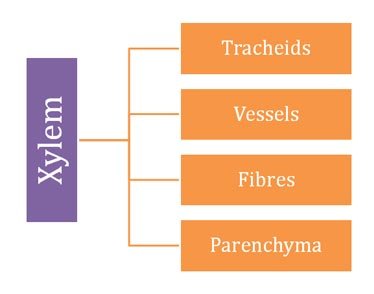 Tracheids are the only xylem element in Pteridophytes. In Gymnosperms, major portion of the secondary xylem composed of tracheids. In Angiosperms, tracheids occur with other xylem elements. In some primitive Angiosperms such as Drimys, Trochodendron, Tetracentron, the xylem composed only of tracheids (vessels absent).
Tracheids are the only xylem element in Pteridophytes. In Gymnosperms, major portion of the secondary xylem composed of tracheids. In Angiosperms, tracheids occur with other xylem elements. In some primitive Angiosperms such as Drimys, Trochodendron, Tetracentron, the xylem composed only of tracheids (vessels absent).
Patterns of secondary thickening in tracheids
The secondary cell wall materials are laid down on the lateral walls of the tracheids in specific patterns. The most common patterns are the following types:
(a). Annular thickening: Secondary wall thickening occurs as rings arranged one above the other. Annular thickening is considered as the most primitive type of wall thickening.
(b). Spiral thickening (helical thickening): Here the secondary wall materials is deposited in the form of spirals along the inner wall of the tracheids.
(c). Scalariform thickening (ladder like thickening): The wall materials are deposited as transverse bands along the wall. The bands are with few interconnections.
(d). Reticulate thickening (net-like thickening): Here the wall thickening pattern is net-like (reticulate).
(e). Pitted thickening: It is the most advanced type of secondary wall thickening in tracheids. Here, the secondary wall materials are evenly distributed over the inner portion of the cell and the cell wall looks more or less uniform in their thickness. Many pits are distributed over the cell wall. Nature and arrangement the pits vary in different plant groups. The pits may be circular or elongate bordered type. Scalariform pitted thickening is a highly advanced type of pitting pattern where elongated bordered pits are arranged in a ladder like (scalariform) pattern.
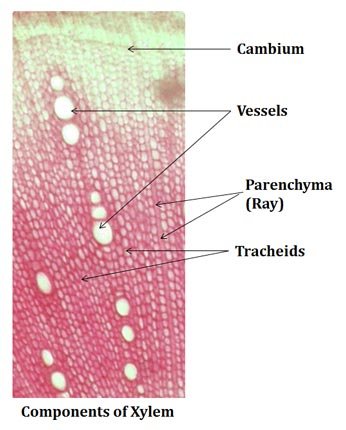 Structural advancement of tracheids in relation to their functions
Structural advancement of tracheids in relation to their functions
Tracheids are specially adapted to do its function such as the conduction of water and mineral and providing mechanical support in plants. The structural advancements of tracheids which best suits to do these functions are given below:
Ø Tracheid cells are elongated with tapering ends
Ø Cells are devoid of any protoplasts at their maturity (ensure easy flow of water)
Ø Thick lignified secondary cell wall (provide mechanical support)
| You may also like NOTES in... | ||
|---|---|---|
| BOTANY | BIOCHEMISTRY | MOL. BIOLOGY |
| ZOOLOGY | MICROBIOLOGY | BIOSTATISTICS |
| ECOLOGY | IMMUNOLOGY | BIOTECHNOLOGY |
| GENETICS | EMBRYOLOGY | PHYSIOLOGY |
| EVOLUTION | BIOPHYSICS | BIOINFORMATICS |
Ø Lateral walls and end walls are provided with pit pairs (facilitate lateral conduction of water)
Ø Cells are placed end to end to the long axis of the organ in which they occur.
Ø Water and mineral passage takes place through pit membrane
Ø Torus of pit act as valves which can regulate the passage of water
(2). Vessels
Vessels (also called as trachea) are the second category of xylem elements composed of short and tube like cells. Vessels are arranged as a series in an end to end fashion to the long axis of the organ in which they occur. Components of the vessel are called vessel segments or vessel element. Each vessel elements are shorter than tracheids in their length; however, the diameter of the vessel lumen is much larger than that of tracheids. The cells are non-living and they are devoid of protoplast at their maturity. Numerous pits are present in the lateral walls of the vessels for communication.
Learn more: Difference between Vessels and Tracheids
Distribution of vessels among plants
Vessels occur mainly in the xylem of Angiosperms. Usually, vessels are absent in Pteridophytes and Gymnosperms. The wood of Gnetum, an advanced Gymnosperm, contains plenty of vessels. The presence of vessels in the secondary wood of Gnetum is considered as one of the strongest evidence for the Gymnospermic origin of Angiosperms and thus Gnetum acts as a connecting link between Gymnosperms & Angiosperms.
Very rarely vessels are also present in some Pteridophytes such as Pteridium, Selaginella and Equisetum. In some primitive Angiosperms, such as Trochodendron, Tetracentron and Drimys, the vessels are absent. Aquatic plants usually do not have vessels in their poorly developed xylem. Xylem in aquatic plants will be ill developed, since these plants do not require a well specialized water conducting system.
Some parasitic plants and few succulent plants also do not show vessels in their xylem. In some monocots like Dracaena and Yucca, vessels are completely absent. The absence of vessels in these plants is due to the evolutionary reduction.
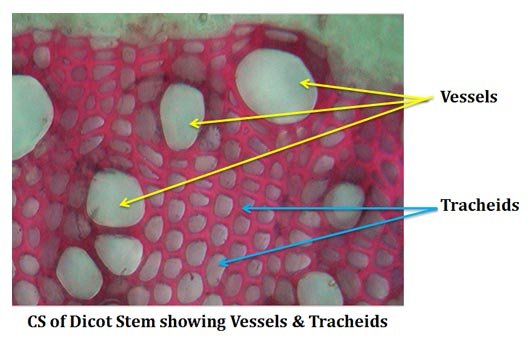 Structure of Vessels in relations to its functions
Structure of Vessels in relations to its functions
Vessel system is made up of a series of cells placed end to end as a long tube like structure. Each cell is called vessel member or vessel element. Each vessel member has perforations (large openings) at their end walls for the easy passage of water and minerals between the cells. Usually, vessels members are shorter than tracheids. However, the diameter of vessels is much larger than tracheids. This facilitates a rapid and efficient flow of water through the vessel lumen.
In highly advanced forms, the vessel cells are with shorter length and wider diameter and they appear as drum shaped structures (as in Quercus alba). The end wall of each vessel members is oblique or transverse. Vessels with oblique end are considered as primitive, whereas those with transverse ends are treated as highly advanced. In some plants, such as Malus, tail like tip occurs beyond the end wall. The openings or pores in each vessel end wall are known as perforations (Perforation plate: the region of the vessel with perforation occurs). Usually perforations occur at the end wall, sometimes lateral perforations also occur on the walls.
Different types of perforation plates seen in vessels are:
1. Simple perforation plate: a plate with single perforation (advanced type)
2. Multiple perforation plate: many perforations
3. Scalariform perforation plate: a multiple perforation plate with perforations arranged in parallel series. The wall region of pores in scalariform perforation plate is called as perforation bar
4. Reticulate perforation plate: pores arranged in reticulate fashion
5. Forminate type perforation: many pores arranged more or in a less circular pattern. This type is also called Ephedoid perforation plate.
Secondary wall of Vessels
The secondary wall thickening of vessels is similar to that of tracheids. Different types of thickenings pattern seen in vessels are Annular thickening, Spiral thickening (helical), Scalariform thickening, Reticulate thickening and Pitted thickening.
The pitted thickening is a characteristic of the vessels of meta-xylem and secondary xylem. The pits on the xylem are commonly bordered type. The distribution pattern of pits varies greatly in different plant groups. The pits are distributed in three basic patterns, they are:
1. Scalariform pitting: elongated with pits in ladder like arrangement
2. Opposite pitting: pits arranged in horizontal rows in pairs
3. Alternate pitting: pits arranged in diagonal rows
Differentiation of vessels
The primary xylem vessels are formed from the longitudinal cells of the pro-cambia. The secondary xylem vessels are formed from cells of vascular cambium. Initials of vessels in both cambia are called primordial vessel members. Primordial vessels members have dense cytoplasm with prominent nucleus. Vessel’s secondary cell wall is laid down by the content of primordial cell. Secondary wall layers are deposited in a pattern characteristic of the given type of vessel element.
The perforation areas are not thickened by deposition of wall materials. After the secondary thickening is complete, the protoplasm of the primordial cell disintegrates. The vacuole secretes many hydrolytic enzymes which degrade the primary cell wall region which is not covered by lignified secondary wall. The non-cellulosic components in the perforation plate are degraded, leaving cellulose micro-fibrils intact. Protoplast completely disappears once wall deposition is completed. Dead cytoplasm forms a layer over the inner side of the lumen called Warty layer.
Structure of vessels in relation to its functions
The main function of vessels is conduction of water and nutrients. Apart from this, vessels also provide mechanical support. The structure of vessel is best suited to do these two functions. The vessel elements are arranged end-to-end to form long tube like channels. This is suitable for uninterrupted passage of water along with minerals. Thick lignified cell wall provides mechanical support.
Evolutionary origin of vessels in Angiosperms
The vessels are believed to be originated from the tracheids. In Angiosperms, the vessels originated from tracheids with pitted, reticulate or helical secondary thickening. The formation of the perforation plate of vessels at the end wall of each vessel element is considered as the most important event in stelar evolution.
(3). Xylem Fibres
Xylem fibres are the third components of xylem and it is also called as xylary fibres. Similar to tracheids and vessels, they are also dead cells and they do not contain protoplast at their maturity. Cells are with very thick lignified secondary cell wall. The main function is to provide mechanical support. There are two types of xylary fibres, they are:
1. Fibre tracheids
2. Libriform fibres
Fibre tracheids are longer than tracheids and they have apical intrusive growth. Fibre tracheids have less developed bordered pits.
Libriform fibres are highly specialized fibres. They have simple pits on their walls. Gelatinous fibres are special category of xylem fibre found in the tension wood (a reaction wood in Angiosperms). The secondary cell wall of gelaginous fibres do not have lignin but have cellulosic cell wall. Thus this part of cell wall appears as gelatinous in cross section. Gelatinous fibres are highly hygroscopic and they can absorb and store plenty of water.
(4). Xylem Parenchyma
Xylem parenchyma is the fourth component of xylem. It is the only living component in the xylem. The cells are with plenty of cytoplasm and prominent nucleus. They have thin cellulosic cell wall. Lignified secondary cell wall is absent in xylem parenchyma. Very rarely parenchyma cells in the secondary xylem undergo secondary growth. Parenchyma in the xylem can store starch, oil and other ergastic substances.
Classification of Xylem Parenchyma:
Two types of xylem parenchyma occurs in the xylem
(a). Axial parenchyma
(b). Ray parenchyma
(a). Axial parenchyma
Axial parenchyma is originated from the elongated fusiform initials of the cambial cells. They are arranged parallel to the long axis of the organ in which they occur.
(b). Ray parenchyma
Ray parenchyma originated from the ray initials of the cambium. There are two types of ray parenchyma in the xylem.
(A). Procumbent ray cells: long axis of the cell are radially elongated
(B). Upright ray cells: long axis of the cell vertically elongated
Based on the composition of cell types, two types of rays occur in the xylem:
Ø Homocellular ray: composed of single type of ray cells (either procumbent or upright).
Ø Heterocellular ray: composed of both types of ray cells (procumbent and upright)
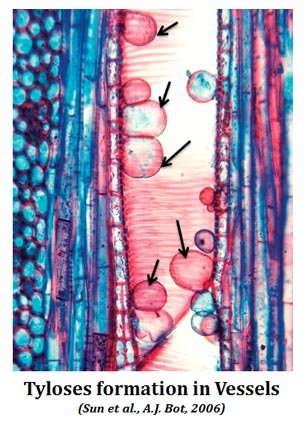 Tyloses
Tyloses
Tyloses are the outgrowth of parenchymatous cells to the lumen of tracheids or vessels of the secondary xylem through pit openings. Tyloses accumulate resins and other secondary materials in their protoplasm. They are responsible for the characteristic odor of wood. They also prevent the degradation of wood by termites and mites.
Classification of xylem:
Based on origin, xylem classified into two groups
Ø Primary xylem
§ Protoxylem
§ Metaxylem
Ø Secondary xylem
Primary xylem
Primary xylem is formed during the primary growth of the plant. It is derived from procambium (a meristem) and consists of two parts namely Protoxylem and Metaxylem. Protoxylem is the first formed xylem and it contains fewer amounts of tracheary elements and more amount of parenchyma. Usually proto-xylem gets destroyed during the maturation of the plant. Metaxylem is derived or differentiated after protoxylem in the vascular bundles. Metaxylem usually contains more tracheary elements than parenchyma. Plants without secondary thickening, metaxylem are functional xylem part throughout the life cycle of the plant. Those plants with secondary thickening the metaxylem are replaced by the secondary xylem.
Learn more: Difference between Protoxylem and Metaxylem
Secondary xylem
Secondary xylem is the xylem formed during the secondary growth of the plant. It is developed from the vascular cambium (a lateral meristem). The main function is the conduction of water and mineral in the secondary plant body. They also provide mechanical support.
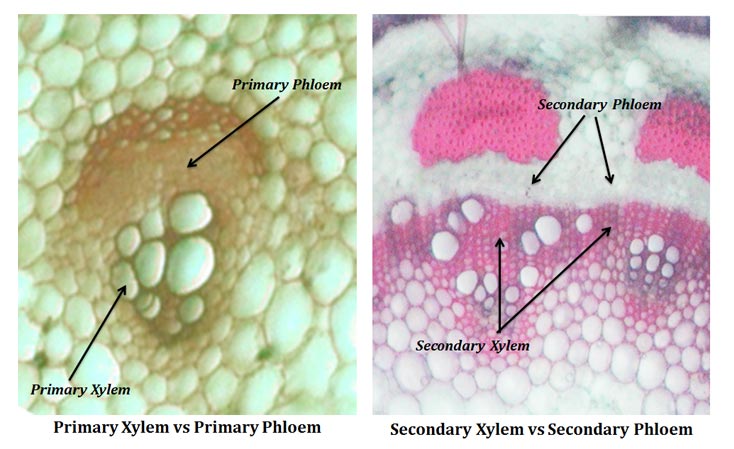 Function of Xylem
Function of Xylem
Ø Conduction of water from roots to leaves
Ø Conduction of minerals and nutrients from roots to leaves
Ø Provide mechanical support
Ø Ray parenchyma forms tyloses which store ergastic substances
Ø These ergastic substances give the wood a characteristic colour and odour
Ø Ergastic substances present in the tyloses also protect the wood from termites and mites.
| You may also like... | ||
|---|---|---|
| NOTES | QUESTION BANK | COMPETITIVE EXAMS. |
| PPTs | UNIVERSITY EXAMS | DIFFERENCE BETWEEN.. |
| MCQs | PLUS ONE BIOLOGY | NEWS & JOBS |
| MOCK TESTS | PLUS TWO BIOLOGY | PRACTICAL |
